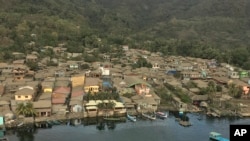The dust has yet to settle from the Taal Volcano, which shot magma and ash miles above a Philippine island last month and displaced more than 200,000, but residents are starting to return as the crisis now enters a recovery phase.
Aid money has poured in and Filipinos are leaving evacuation centers as authorities say the threat has decreased of another eruption from the volcano, which is in a lake on an island in a second lake, on yet a third island. The Philippines was worried about more aftershocks from the eruption, because it had already set off earthquakes, destroyed roads and bridges, and killed wildlife and vegetation from horses to pineapples.
With the threat of a Pompeiian disaster decreased, locals now face the worry of whether in the long term they can live and have a livelihood near the volcano, which has erupted dozens of times in history. The local economy depends on tourism, agriculture and fishing. The latest eruption, which started Jan. 12, has already caused economic losses of $150 million, according to the Philippines National Economic Development Authority.
“We cannot live on donations for a long time because we need to provide for our families, sustain the education of our students,” said Daniel Reyes, mayor of Batangas, the capital of the province where Taal is. He was appealing for aid from the Philippine House of Representatives, which is preparing to vote on an aid package.
“We beg you to rebuild a fortified and a more resilient community,” he said.
Meanwhile residents are depending on donations of things from food to diapers to power generators, and assistance from the Red Cross with such things as medical care, evacuations and animal rescues.
Besides donations in kind, government aid includes $830,000 from the European Union, $200,000 from South Korea, and $150,000 from China.
The EU wants to help “ensure affected people get protection and have enough means to survive through this difficult time and get back to their feet at the earliest possible,” Janez Lenarcic, the EU commissioner for crisis management, said.
Beyond the cash aid, Filipinos will have to deal with broad issues such as government services, infrastructure, and public health. There were no apparent deaths caused directly by the eruption, although dozens have been reported dead in the aftermath, such as those who suffered heart attacks at evacuation centers.
The Philippines Health Department is advising residents to wear surgical masks and be alert for effects from the volcanic ash and dust. Some have already been treated for such consequences as respiratory infections, skin lesions and flu.
The department ordered hospital staff to stay on standby and freeze prices on basic medicines in the province, including antibiotics, cardiovascular and antibacterial drugs, and disinfectants.
“We are continuously monitoring the developments of the eruption and will respond to the health needs of the people,” Health Secretary Francisco Duque said.









